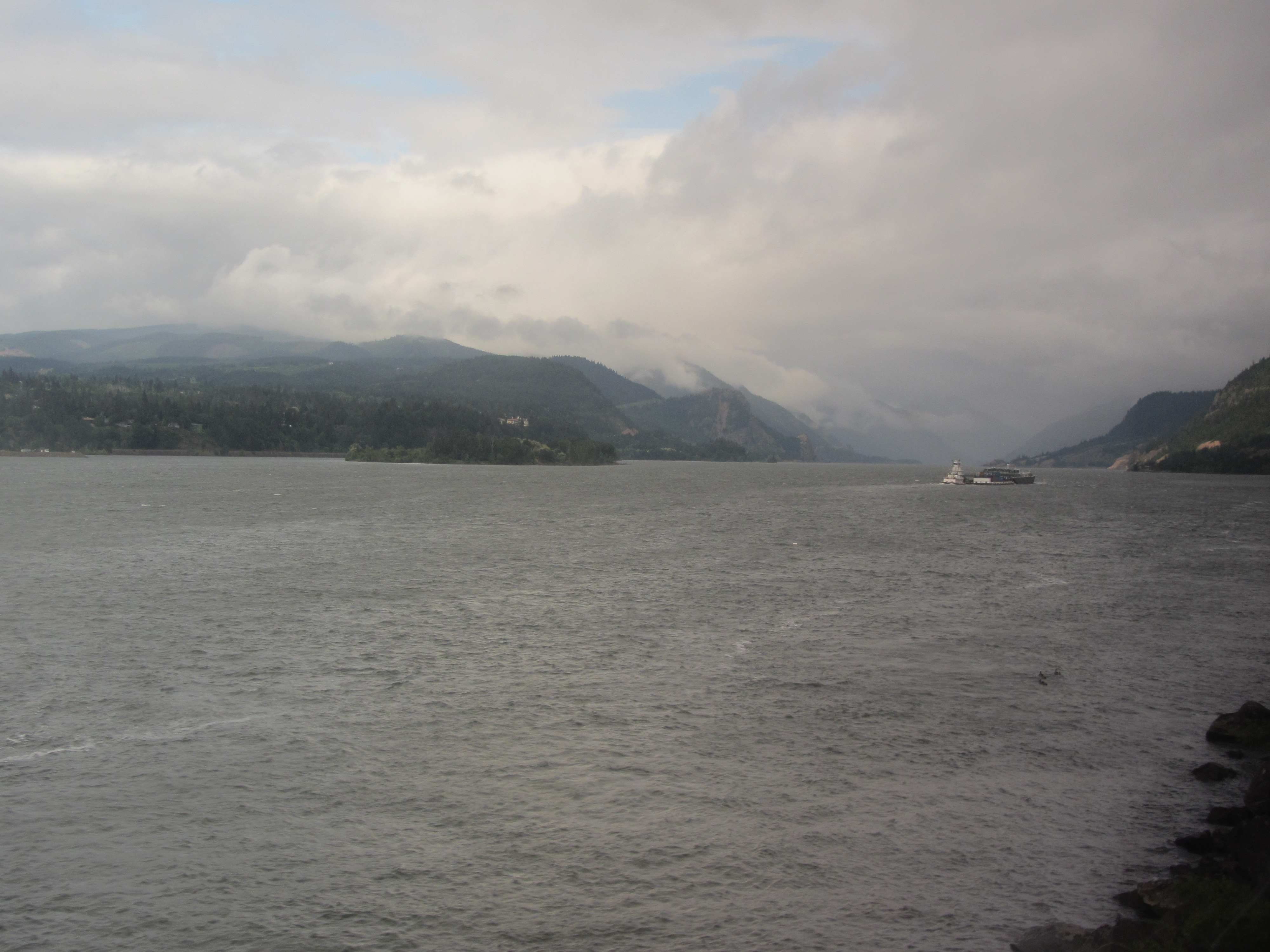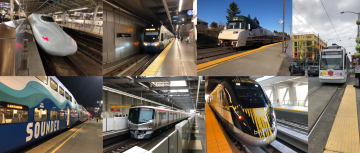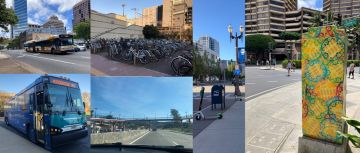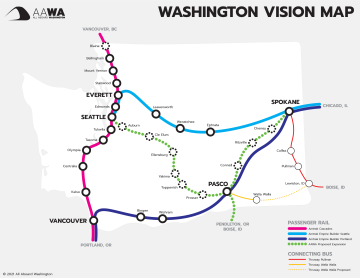Seamless, Statewide Transportation
Achieving AAWA's Goal
What is World-Class Transportation?
It's More Than Just Trains
It Really Boils Down to One Simple Question:
Is it reasonably easy to get from here to there?
Within many of our state's urban areas, it's reasonably easy to get around without a car. But what if you need to get to school or medical care elsewhere in Washington? Here are a few examples.
Click the links, then "More options" for details. The actual times vary. Note that the arrival time might be the next day.
Seattle to Pullman
Driving: 4 hours 45 minutes / Transit: 10 hours 25 minutes
Redmond to Walla Walla
Driving: 4 hours 25 minutes / Transit: 12 hours 17 minutes
Seattle to Yakima
Driving: 3 hours 2 minutes / Transit: 19 hours 20 minutes
Aberdeen to Pasco
Driving: 5 hours 4 minutes / Transit: 13 hours 17 minutes
Ellensburg to Cheney
Driving: 4 hours 43 minutes / Transit: 6 hours 29 minutes
Spokane to Boise
Driving: 6 hours 40 minutes / Transit: 22 hours 47 minutes
The Transportation Future Should Run on Rails Today
We need more frequent and faster trains running as soon as possible on existing infrastructure.
As called for in state law RCW 47.79 passed by the Legislature in 1993:
The legislature recognizes that major intercity transportation corridors in this state are becoming increasingly congested. In these corridors, population is expected to grow by nearly forty percent over the next twenty years, while employment will grow by nearly fifty percent. The estimated seventy-five percent increase in intercity travel demand must be accommodated to ensure state economic vitality and protect the state's quality of life.
The legislature finds that high-speed ground transportation offers a safer, more efficient, and environmentally responsible alternative to increasing highway capacity. High-speed ground transportation can complement and enhance existing air transportation systems. High-speed ground transportation can be compatible with growth management plans in counties and cities served by such a system. Further, high-speed ground transportation offers a reliable, all-weather service capable of significant energy savings over other intercity modes.
Expand Rail Options Available Today
- Amtrak Cascades to Eugene, Portland, Seattle and Vancouver, BC (restarting soon)
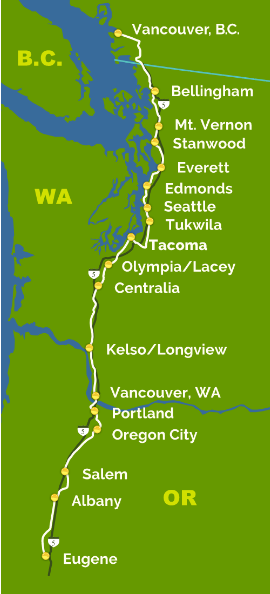
- Sounder regional rail to Everett, Seattle and Tacoma
- Amtrak Coast Starlight, Seattle to Los Angeles
- Amtrak Empire Builder, Seattle and Portland to Chicago
Add East-West Service, Additional Frequencies, New Stations and Connecting Buses
- Frequent Amtrak trains crossing the entire Northwest
- More stations
- A competitive freight rail system
- Better connections to other modes
Start planning now for high-speed rail in twenty years
We Support High Speed Rail as Part of an Integrated System
- Almost all high-speed rail systems–including China, Japan and most of Europe–have been built on a foundation of a robust conventional rail system.
- The High Speed Rail Alliance envisions an integrated network approach including high-speed, regional and shared-use lines.
Our Vision
A transportation network that:
- Provides seamless, door-to-door connectivity for our region’s people and goods
- Offers economic, environmental, and equity benefits to all communities
Economy, Environment, Equity
Rail is an ideal option for addressing ‘the 3 Es’
Economic Benefits
Easy travel options help strengthen local economies throughout the Northwest.
- On average, communities receive $84 per day-trip visitor, and $366 per overnight visitor, according to Experience Washington.
Environmental Benefits
Rail is the optimal low-impact freight and passenger ground transportation option.
- Rail does not contribute to salmon die-off related to tires.
Equity Benefits
A good freight and passenger rail network contributes to high quality of life in our region for everyone.
- Improves reach of local services
- Expands access for all communities
Our Rail Policy Recommendations
A broad-based group of transportation, environmental, health care and community organizations have jointly published a statement of policy recommendations focusing on the importance of rail in meeting the state’s goals of improved economy, environment and equity.
Improved rail transportation is a solution to both transportation equity and climate challenges. Investment in rail provides benefits such as jobs, equitable access, improved mobility, health and safety of railway workers and the public, reduced greenhouse gas emissions and pollution, reduced highway infrastructure damage and congestion.
Our Legislature needs to recognize the importance of a robust rail transportation appropriation that positions Washington to leverage grant opportunities such as offered by the Infrastructure Investment and Jobs Act given that most federal grant opportunities require matching funds. Washington state must be proactive in developing project plans that are ready for construction when funding becomes available.
We support Governor Inslee’s and the Legislature’s commitments to clean transportation. However, statistics show that Washington is not on track to fully achieve its climate goal of reducing greenhouse gas emissions by 50% by 2030. Rail must be the backbone of our surface transportation network because of its energy efficiency, low carbon emissions, electrification potential, and reduction in vehicle miles traveled.
The full statement is linked here.
AAWA’s Legislative Priorities
- Restore Pre-Pandemic Rail Services
- Expand Research on a Complete, Statewide Passenger and Freight Rail Network
- Follow in Virginia’s footsteps
- Form a Washington Rail Advisory Committee
- Give rail users and stakeholders a louder voice, similar to the Ferry Riders Opinion Group and organizations in other states
- Improve Rail Safety
- Activate County Rail Districts
County rail districts (CRDs), established under RCW 36.60, are an option for funding rail infrastructure improvements in Washington. - Improve Regional Corridor Management
Improving coordination between ODOT and WSDOT will help Cascades build upon the success it has experienced over the past several years. - Create a Northwest Rail Compact
Regional Rail Compacts are authorized by Sec. 22306 of the Investment in Infrastructure and Jobs Act (IIJA). Objectives of such a compact are initially to:- Study restoration of Pioneer route
- Study of north-south rail connections
- Study of Thruway and local bus connections
How You Can Help
- Ask Legislators to Support Local Match Funding for IIJA
- Flexible match funds prepare us for federal grants
- Rethink the Conversation on Transportation and Access
- Be open-minded, discuss a broad list of ideas
- Priority Projects List
- Locally-supported projects to bring to Olympia
- Support AAWA!
- Ask Other Transportation, Environmental, and Health Care Groups to Endorse Our Joint Statement
- Help Expand Our Community Coalitions
- It Takes Transportation supports a transformative approach to transportation that meets our needs for health, safety, and affordability, and addresses climate, social, and economic justice.
- Week Without Driving asks: what is it like to try to get around your community without driving yourself?
- Washington Can't Wait is an initiative to fight for action on climate change, environmental justice, and housing equity.
- Invite AAWA to speak to your group about our vision. Contact us!
Support AAWA’s Work and Vision
Help us improve transportation options for everyone in the state. Support AAWA!
